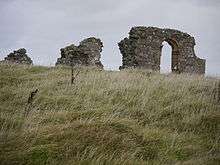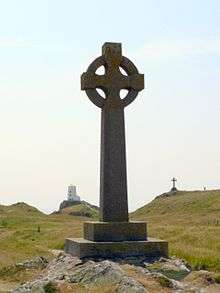Dwynwen
Saint Dwynwen (Welsh pronunciation: [ˈdʊɨnwɛn]; fl. 5th century), sometimes known as Dwyn or Donwen, is the Welsh patron saint of lovers. She is celebrated throughout Wales on 25 January.
Dwynwen | |
|---|---|
| Major shrine | St Dwynwen's Church Ynys Llanddwyn, Anglesey |
| Feast | 25 January |
| Patronage | Lovers in Wales |
History and Legend
Dwynwen is believed to have been a daughter of King Brychan Brycheiniog, who lived in the 5th century. Her mother may have been Rigrawst.[1] Dwynwen lived in Anglesey, and her name is still recalled in place names such as Ynys Llanddwyn and Porthddwyn in Wales and the church of Sen Adhwynn in Advent, Cornwall.
In the tale told of her, Dwynwen falls in love with a young man named Maelon, but rejects his advances. Stories differ substantially on the events that follow but the outcome remains the same. Either she is raped by Maelon and prays for assistance, or she is unable to marry him due to her father's refusal and prays to forget her love for him. An angel provides her with a potion. Maelon drinks it and turns into ice. Dwynwen then prays for three requests (either given as a result of drinking the potion, or prayed for when she sees what happens to Maelon). These three requests are that Maelon be released; that, through her, God look after all true lovers; and that she remain unmarried. She then retreats to the solitude of Ynys Llanddwyn off the west coast of Anglesey to become a hermit until she dies, in about AD 460; although it has been written in some texts that she had fled there because of her fear of Maelgwn Gwynedd.[2]
Feast Day and Commemoration
St Dwynwen's Church on Ynys Llanddwyn became an important shrine during the Middle Ages.[1] The holy well became a site of pilgrimage, at which the movement of fish within its waters was believed to indicate lovers' destinies.[3]

Following the Reformation, devotions at her shrine were suppressed, and the site itself quickly fell into disrepair through the effects of numerous sandstorms. Those pilgrims who still came to pray in the area visited Saint Elian's Well instead.[4] During the nineteenth century, the Anglican Church rediscovered traditional devotions, in the course of which in the 'sixtieth year of Queen Victoria', probably 1879, a plain cross about fourteen feet (4.2m) high was erected in memory of Dwynwen.[5]
In 1903, a Celtic cross was erected near the ruins of the church by the Hon. F. G. Wynn of Glynllivon, son of the 3rd Baron Newborough, also in memory of its patroness.[6] The site is now part of a nature reserve.[4]

Calendars from the fifteenth century and later give 25 January as the day commemorating St Dwynwen in Wales. Nicolas Roscarrok, however, gives as her day 13 July, and opines that 'St Dwin' is the same as 'Dwinwen'. In his Calendar he gives 25 January as the day of 'Dwinwent' or 'Damwent'.[6]
During the 1960s, a student at University College, Bangor, Vera Williams, sought to revive the observance of St Dwynwen's Day by commissioning four designs for St Dwynwen's Day cards, in the style of a "Welsh Valentine's Day". Another local press adopted the idea, and by 2004 the celebration of 25 January as a festival for Welsh lovers was so well established that even Gwynedd Council was promoting it.[4]
St Dwynwen is not officially commemorated in the liturgies of the Catholic or Anglican Churches; she does not appear in the 2004 edition of the Roman Martyrology,[7] nor the Roman Catholic calendar for Wales,[8] nor the 1995 revision of the Church in Wales calendar.[9]
She is also the patron saint of sick animals.
See also
- Adwen, the related Cornish saint
References
- Brian Daniel Starr, Ascent of the Saints: Whose Lineage Is Known (Google eBook)(Brian Daniel Starr, 2009) page 73.
- Farmer, D. H., (1978) The Oxford Dictionary of Saints. Oxford: Clarendon Press.
- FAQ on St Dwynwen Archived 27 January 2012 at the Wayback Machine from the Museum of Welsh Life, accessed 31 October 2011
- Santes Dwynwen / Saint Dwynwen, bilingual book by Catrin Stevens, 2005, Gomer Press
- 'St Dwynwen's Cross', wales_picture.cfm?p=3829 at blacklisted Stay In Wales website, accessed 10 February 2012
- 'Llanddwyn Island', Hugh Owen, in Transactions of the Anglesey Antiquarian Society and Field Club, also citing Llanstephan MS 117; web version accessed 10 February 2012.
- Martyrologium Romanum, 2004, Vatican Press (Typis Vaticanis).
- National Calendar for Wales, accessed 6 February 2012
- The Alternative Calendar and Lectionary of the Church in Wales, accessed 10 February 2012
External links
- Diwrnod Santes Dwynwen - St. Dwynwen's Day
- St Fagans National History Museum page on St Dwynwen's Day
- Celebrating Diwrnod Santes Dwynwen with your loved one
- St Dwynwen's Day
- St. Dwynwen at catholic.org
{{Category:Days celebrating love]]